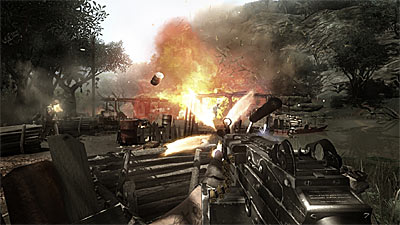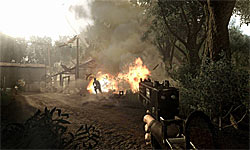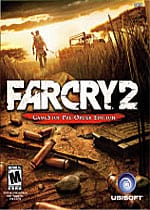A Near-Perfect Union of Sandbox Play and First Person Tactics
It’s a delicate undertaking trying to achieve a sensible equilibrium between the pursuit of pure aesthetics and artificial intelligence. Many games get lost along the way, forfeiting one for the other. That’s why Far Cry 2 is such a resounding achievement: it not only marries beauty and brains, but throws in a significant amount of player choice into that delicate mix.

His voice is a little hard to hear over the puttering of the engine and the clatter of the tires meeting the dilapidated wooden bridge, but your guide has an agenda to cover. As the jeep cuts through the countryside giving you a proper view of the scenery, he tells you about the two warring factions – The United Front for Liberation and Labor and the Alliance for Popular Resistance (and their partner in habit), an arms dealer known as the Jackal. The middleman always comes out best: by supplying both warring sides with weapons, the Jackal is able to control the purse strings of the conflict for maximum profit. That’s why it’s your job to stop him.
The closer you get to your hotel the more you realize something isn’t right: sweat isn’t uncommon in this kind of heat, but you’re pouring buckets and feeling nauseas as you clench the seat in front of you. Top that off with some blurry vision and all you want is sleep. The guide says it’s malaria and not to worry – it happens to everyone, but you’re going to need medical help soon. You pass out and wake up in your hotel room. There’s only one problem: it’s on fire! Instead of the townsfolk rolling out a welcome mat, they’ve decided you’re not wanted. One case of malaria, a local shootout, and a thoroughly toasted flophouse – that’s the first ten minutes of the game.
Far Cry 2 uses the introductory train rides in both installments of Half-Life as a thesis and gives it an action-coated spin. The comparison with Half-Life provides a reference, but a full analogy to Half-Life would be incorrect. The opening section of Far Cry 2 is an on-the-leash setup in a two-fold manner: like Half-Life, it’s setting the stage (in terms of plot and environment), but it also wants to play around with diametrical conventions. The developers are saying, “There’s a time for the chaperon led experience and we demonstrated that. From here on out, we let you take on anything in any way you choose.”

Choice tagged to variety – that’s always been the power of the Far Cry series. Players of the first game had fun discussing how they tackled a mission in their own manner. It wasn’t uncommon to hear a person claim, “Oh, well I crawled through the brush, taking out one guard at-a-time,” only to hear another say, “That’s not exciting. You’ve got to strap an explosive charge to a vehicle and ram it into the nearest guardhouse.” In Far Cry 2, varied choice returns in an even more developed form.
You start with missions you can accept from either faction. There’s always a straightforward objective, whether it be more supply oriented – such as destroying a weapons cache – or more jugular, like an assassination. Let’s use the first category and an example mission to show how choice is deeper. One of your first missions has you destroying a faction’s latest shipment of weapons. You can run in, guns blazing, but that requires a lot of firepower and will be a drawn out affair. Another option is to venture to a safe house (which functions as a save point) and set your alarm for late at night. Now, when you go in, many of the guards will be lethargic, giving you a leg-up on the situation. Then there’s the always-present third option: you can use your new friendship with a mercenary buddy to good effect. He can create a distraction, luring half the troops out the base, and in turn making your assault a more manageable proposition.

Keeping tabs on all those options (and many more) isn’t a problem thanks to your capable inventory. The map, which features multiple levels of zoom and GPS, make it easy to keep tabs on objectives, where you are, and where you need to be going. You can also do your own form of tagging. By scouting out positions early with the monocular, you can mark important points of reference on your map, like health stations, vehicles, ammo piles, and mounted weapons. Don’t assume the wilderness breaks the telecommunications barrier. Your in-game phone allows you to get proper updates in the middle of missions. Even though missions are spread apart, your transportation options aren’t limited to your own two feet. You can commandeer vehicles and, even if they get shot up, there’s always the option to hop out and repair them. There’s also a bus system that teleports you across vast sections of the map.
As you’re wandering the 31 miles of in-game wild, you won’t be able to ignore the scenery on display. Not only is the draw distance fantastic – you can literally see for many in-game miles – but normal barriers to immersion presented in many other games simply aren’t there. When you push through a dense patch of jungle, it feels that way. Instead of sliding through the bush (as if it has no mass), your character pushes aside branches and flattens smaller plants and, realistically, they swing back to their original positions. Effects like the sun obscuring your vision, the fast-forwarding of time when you rest, and fire that spreads across patches of dry grass, complement the realistic environment on display.
Take note though: beauty is not only skin deep. Bridges that look like they will crumble, will crumble – given the right push. You can drive a jeep through their flimsy rails and careen into a shallow riverbed. Buildings constructed out of shoddy two-by-fours and scrap metal can be blown apart, sending the rudimentary building materials in many directions. Even your body is apt for gross display, destruction, and a somewhat rough form of resurrection. If your health meter dips to one bar, you’re in dangerous territory – that remaining bar will drain, rendering you a corpse.

However, you can perform some nasty frontier medicine. The animations are chosen at random and look gruesome every time. Pulling a bullet out of your thigh with pliers or digging a slug out of your arm with a knife is hellish but also a functional design choice. By not opting for a regenerating health system, Far Cry 2 forces you to think before you go into a fight. You can’t just hide behind a rock and wait for your health to heal – constitution is a truly limited resource.
You will take damage and have to endure those patch-up animations frequently due to the rock solid A.I. that Far Cry 2 employs. Enemies take cover in traditional ways – like hiding behind rocks and walls – and they use an ample amount of stealth. They’ll often creep through shallow grass to sneak up on you. You might think you’ve encountered one soldier, only to find three more sprout out of the ground. They work together in other ways too. One may shout, “I’m out! Reloading!” and his teammate will unload fire on your position so his partner can change out a clip. In a nod to the realism, sometimes things get comical. You may set off an explosion near a jeep, which sends it sliding down a hill into a river bed. The gunner may bail out early, while the driver nervously slams on the gas, hoping against the laws of physics that he can stop his inevitable descent.
All this mercenary risk doesn’t come at little reward. Shunning standard forms of currency, the citizens of the in-game economy only take diamonds. You are awarded these once you accept contracts (there are also bonus cases of diamonds scattered around the world), and you can use them to purchase upgrades for your vast inventory. By visiting a weapons store, you can unlock new weapons, upgrade their accuracy and reliability, and increase their ammunition capacity. It’s a smart system: it introduces an RPG-like element – something normally not seen in first person shooters.
Developing such a robust world is a feat in itself, and giving players the keys to design their version of it is a gracious offer. Far Cry 2’s map editor puts a lot of options at your fingertips. You can play around with templates for settings like a desert oasis or mountain valley, or just start from a barren plot of dirt. After that becomes your playground – throw down roads, setup fortresses, raise or lower ground – there’s not a lot you can’t do. A nice feature is the performance indicator bar. When it’s green, it means that the map, as laid out, will run smoothly. Once it hits orange, you need to start optimizing, and if you hit red, be prepared for some shuddering. Any map can be saved and then shared with the Far Cry 2 community.
Taking a page from Call of Duty 4: Modern Warfare, all the multiplayer modes – Deathmatch, Team Deathmatch, Capture the Diamond, and Uprising – allow you use a particular class of character. Each class has its own strengths. For example, Guerrillas can carry IEDs and Saboteurs pack a dart rifle and silenced handgun. Once you start gaining XP the standard load outs – like the Commando’s G3-KA4 and Star .45 – they get upgraded with more lethal negotiators, like an AK-47 and M-79 Grenade Launcher. This upgradeable class system breathes much need variety into the otherwise standard multiplayer modes. Deathmatch and Team Deathmatch are self-explanatory, and first-person shooter staples like Capture the Diamond just replaces the conventional flag with a canister of diamonds. Uprising offers a little bit of a twist. You cap points on the map, but instead of just holding them, the team that captures all the points first and then tries to assassinate the leader of the other team.
It’s a common assumption that the big kid in the sandbox is Grand Theft Auto and that shooters aren’t welcome to play. Far Cry 2 kicks up the sand and shows what a great development team is capable of – delivering an engaging world that puts choice of play at the forefront. Direction is sometimes a developer’s worst enemy, tempting them always to restrict the player. By adopting a laissez faire attitude to player discretion, Ubisoft has crafted a brilliant follow-up.
RATING OUT OF 5 RATING DESCRIPTION 4.8 Graphics
The attention to detail is astounding. There’s always something new on the horizon. Whether the sun is beating down on you, fire is sweeping across a field of dry grass, or an explosion is sending shrapnel across the road, one thing is for sure: rarely do you see this much care put into aesthetics. 4.7 Control
Tight with just the right amount of response. The decision to also show what’s happening – such as your character fixing a vehicle, holding a knife to someone’s throat, or simply setting their watch – lends to a great sense of immersion. 4.4 Music / Sound FX / Voice Acting
A solid score complemented by meticulously recreated ambient noises and fantastic flare-ups of gunfire and room-shattering explosions. The only slight down note is the voice acting – it’s above average for the most part, but many characters seem to be racing through their dialogue. 4.6 Play Value
The single-player campaign is outstanding, and when you factor in the experience-based multiplayer and versatile map editor, you’ve got a game that’s going to keep you busy for a while. 4.7 Overall Rating – Must Buy
Not an average. See Rating legend above for a final score breakdown.
Game Features:
